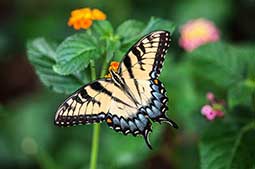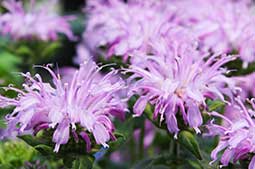Butterfly Gardens

4 Key Elements
Butterflies need these key elements to survive:
- Puddles .... Butterflies cannot drink open water. Wet sand, earth or mud is the best butterfly fountain. Allow your birdbath to overflow to create mud puddles.
- Sunlight ... Butterflies need sunlight for feeding and egg laying, therefore, plants should be in full sun. Butterflies also like open areas so try to keep flowerbeds around the edges of your yard.
- Shelter .... Butterflies need protection from the wind and an undisturbed area for egg-laying and chrysalis formation. Plant brambles, honeysuckle or Buddleia alternifolia to provide ample shelter.
- Food ........ Both larval and adult foods must be provided to maintain the butterflies’ residence in the garden.

Food Sources
Here is a list of good food sources for both Adult Butterflies and their Larvae:
*(A) = adult food & (L) = larval food
- Flowering Plants (A) – Alyssum, Ageratum, Aster (late blooming varieties), Anemone, Astilbe, Aubrieta 'Basket-of-Gold' (Aurinia saxatilis), Bee Balm (Monara sp.), Black-eyed Susan (Rudbeckia sp.), Blazing Stars (Liatris sp.), Butterfly Bush (B. davidi & B. alternifolia), Butterfly Weed (Asclepias tuberosa), Candytuft, Chives, Clematis (C. paniculata), Coneflower (Echinacea sp.), Coreopsis, Cosmos, Daylily, Heliotrope, Joe-Pye Weed (Eutrochium purpureum), Lavender (Lavendula sp.), Lantana (L. camara), Lily, Lilacs, Loosestrife, Mexican Sunflower (Tithonia rotundifolia), Tall Garden Phlox (Phlox drummondi), Primrose, Rose of Sharon (Hibiscus syriacus), Scabiosa, Stonecrop (Sedum spectabile), Tickseed-sunflower (Biden sp.), Thyme, Wisteria, Zinnia.
- Herbaceous plants (L) – Carrot, Dill, Hollyhock, Lupine, Nettle, Plantain, Parsley, Queen Anne Lace, Red Clover, Wild Violets (Viola sororia).
- Trees (L) – Apple, Elm, Hackberry, Hawthorn, Poplar, Willow, and Wild Cherry.
- Butterfly Garden "Must-Haves" (A & L) – All Milkweeds, Dogwood (Cornus sp.), Dogbanes (Apocynum sp.), Heath (Erica cinerea), Cranesbill Geranium (G. sanguineum), Goldenrod (Solidago sp.), Marigold (Tagetes erecta), Thistle (Cirsium sp.).

Create a Garden that Attracts Butterflies
Three things to keep in mind when creating an environment that attracts Butterflies and keeps them coming back:
- Location - Find a location that will allow you to have a good view, but will not be continually disturbed by children and pets. The ideal placement for your butterfly garden is a sunny area that is protected from the wind. Flowers generally produce more nectar in sunny areas. Also, a butterfly’s body temperature needs to be above 85 degrees for flight.
- Garden Design- To attract many butterflies to your garden, you should have a large area of flowering plants (some are listed below). A mixture of perennials and annuals will help you extend the blooming season as early into spring and as late into fall. You should also take into consideration the plants that are food for the adults as well as the plants that caterpillars eat.
- Feeding - Planting flowers and nectar plants will provide excellent food sources. Some butterfly feeders use nectar (6-8 parts water to 1 part sugar) or rotting fruits provide a good source of food (bananas, peaches, apples, etc.). Males need sodium for the mating process therefore, placing a small salt block, like the one used for deer, in your garden can attract butterflies.
